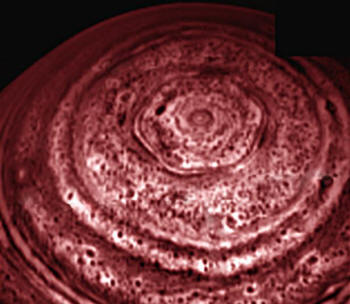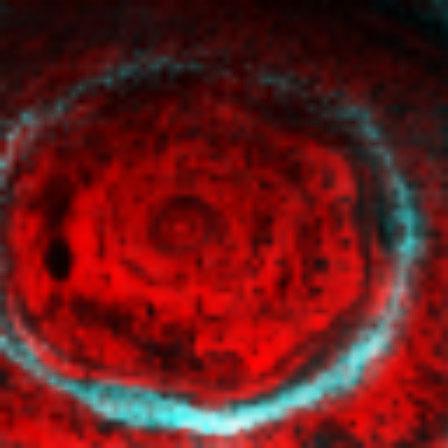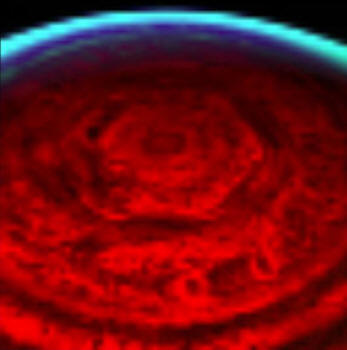|

Contacts:
Carolina Martinez/Jane Platt 818-354-9382/818-354-0880
Jet Propulsion Laboratory, Pasadena, Calif.
March 27, 2007
from
JetPropulsionLaboratory-Cassini-Huygens
Website
|
The hexagon images and movie, including
the north polar auroras are available at:
http://www.nasa.gov/cassini
and
http://saturn.jpl.nasa.gov and
http://wwwvims.lpl.arizona.edu
The Cassini-Huygens mission is a cooperative project of NASA, the
European Space Agency and the Italian Space Agency.
The Jet
Propulsion Laboratory, a division of the California Institute of
Technology in Pasadena, manages the Cassini-Huygens mission for
NASA's Science Mission Directorate, Washington.
The Cassini orbiter
was designed, developed and assembled at JPL.
The Visual and Infrared Mapping
Spectrometer team is based at
the University of Arizona.
|

Saturn's Active North Pole
(see below insert)
|
Saturn's Active North Pole
March
27, 2007
.
A bizarre six-sided
feature encircling the north pole of Saturn near 78
degrees north latitude has been spied by the visual and
infrared mapping spectrometer on NASA's Cassini
spacecraft. This image is one of the first clear images
ever taken of the north polar region as seen from a
unique polar perspective.
Originally discovered and last observed by a spacecraft
during NASA's Voyager flybys of the early 1980's, the
new views of this polar hexagon taken in late 2006 prove
that this is an unusually long-lived feature on Saturn.
This image is the first to capture the entire feature
and north polar region in one shot, and is also the
first polar view using Saturn's thermal glow at 5
microns (seven times the wavelength visible to the human
eye) as the light source. This allows the pole to be
revealed during the nighttime conditions presently
underway during north polar winter. Previous images from
Voyager and from ground-based telescopes suffered from
poor viewing perspectives, which placed the feature and
the north pole at the extreme northern limb (edge) of
the planet.
To see the deep atmosphere at night, the infrared
instrument images the thermal glow radiating from
Saturn's depths. Clouds at depths about 75 kilometers
(47 miles) lower than the clouds seen at visible
wavelengths block this light, appearing dark in
silhouette. To show clouds as features that are bright
or white rather than dark, the original image has been
contrast reversed to produce the image shown here. The
nested set of alternating white and dark hexagons
indicates that the hexagonal complex extends deep into
the atmosphere, at least down to the 3-Earth-atmosphere
pressure level, some 75 kilometers (47 miles) underneath
the clouds seen by Voyager. Multiple images acquired
over a 12-day period between Oct. 30 and Nov. 11, 2006,
show that the feature is nearly stationary, and likely
is an unusually strong pole-encircling planetary wave
that extends deep into the atmosphere.
This image was acquired on Oct. 29, 2006, from an
average distance of 902,000 kilometers (560,400 miles)
above the cloud tops of Saturn.
The Cassini-Huygens mission is a cooperative project of
NASA, the European Space Agency and the Italian Space
Agency. The Jet Propulsion Laboratory, a division of the
California Institute of Technology in Pasadena, manages
the mission for NASA's Science Mission Directorate,
Washington, D.C. The Cassini orbiter was designed,
developed and assembled at JPL. The Visual and Infrared
Mapping Spectrometer team is based at the University of
Arizona, where this image was produced.
|
Pasadena, Calif.
An odd, six-sided, honeycomb-shaped feature
circling the entire north pole of Saturn has captured the interest
of scientists with NASA's Cassini mission.
NASA's Voyager 1 and 2 spacecraft imaged the feature over two
decades ago. The fact that it has appeared in Cassini images
indicates that it is a long-lived feature. A second hexagon,
significantly darker than the brighter historical feature, is also
visible in the Cassini pictures.
The spacecraft's visual and
infrared mapping spectrometer is the first instrument to capture the
entire hexagon feature in one image.
"This is a very strange feature,
lying in a precise geometric fashion with six nearly equally
straight sides," said Kevin Baines, atmospheric expert and
member of Cassini's visual and infrared mapping spectrometer
team at NASA's Jet Propulsion Laboratory, Pasadena, Calif.
"We've never seen anything like this on any other planet.
Indeed, Saturn's thick atmosphere where circularly-shaped waves
and convective cells dominate is perhaps the last place you'd
expect to see such a six-sided geometric figure, yet there it
is."

Saturn's North Pole Hexagon and Aurora
The hexagon is similar to Earth's polar vortex, which has winds
blowing in a circular pattern around the polar region.
On Saturn,
the vortex has a hexagonal rather than circular shape. The hexagon
is nearly 25,000 kilometers (15,000 miles) across. Nearly four
Earths could fit inside it.
The new images taken in thermal-infrared light show the hexagon
extends much deeper down into the atmosphere than previously
expected, some 100 kilometers (60 miles) below the cloud tops. A
system of clouds lies within the hexagon.
The clouds appear to be
whipping around the hexagon like cars on a racetrack.
"It's amazing to see such striking
differences on opposite ends of Saturn's poles," said Bob Brown,
team leader of the Cassini visual and infrared mapping
spectrometer, University of Arizona, Tucson.
"At the south pole
we have what appears to be a hurricane with a giant eye, and at
the north pole of Saturn we have this geometric feature, which
is completely different."

Saturn's Strange Hexagon
(see below insert)
|
Saturn's Strange Hexagon
March
27, 2007
This nighttime view of Saturn's north pole by the visual
and infrared mapping spectrometer onboard NASA's Cassini
orbiter clearly shows a bizarre six-sided hexagon
feature encircling the entire north pole. This is one of
the first clear images taken of the north polar region
ever acquired from a unique polar perspective.
In this image, the red color indicates the amount of
5-micron wavelength radiation, or heat, generated in the
warm interior of Saturn that escapes the planet. Clouds
near 3-bar (about 100 kilometers or 62 miles deeper than
seen in visible wavelengths) block the light, revealing
them in silhouette against the background thermal glow
of Saturn. The bluish color shows sunlight striking the
far limb (edge) of the planet, showing that the entire
north pole is under the nighttime conditions
characteristic of polar winter, as on Earth.
This image is the first to capture the entire feature
and north polar region in one shot, and is also the
first polar view using Saturn's thermal glow at 5
microns (seven times the wavelength visible to the human
eye) as the light source. This allows the pole to be
revealed during the persistent nighttime conditions
under way during winter. The hexagon feature was
originally discovered by NASA's Voyager spacecraft in
1980, but those historic images and subsequent
ground-based telescope images suffered from poor viewing
perspectives, which placed the feature and the north
pole at the extreme northern limb (edge) in those
images.
In the new infrared images, the strong brightness of the
hexagon feature indicates that it is primarily a
clearing in the clouds, which extends deep into the
atmosphere, at least some 75 kilometers (47 miles)
underneath the typical upper hazes and clouds seen in
the daytime imagery by Voyager. Thick clouds border both
sides of the narrow feature, as indicated by the
adjacent dark lanes paralleling the bright hexagon. This
and other images acquired over a 12-day period between
Oct. 30 and Nov. 11, 2006, show that the feature is
nearly stationary, and likely is an unusually strong
pole-encircling planetary wave that extends deep into
the atmosphere.
This image was acquired with the Cassini visual and
infrared mapping spectrometer on Oct. 30, 2006, from an
average distance of 1.3 million kilometers (807,782
miles).
The Cassini-Huygens mission is a cooperative project of
NASA, the European Space Agency and the Italian Space
Agency. The Jet Propulsion Laboratory, a division of the
California Institute of Technology in Pasadena, manages
the mission for NASA's Science Mission Directorate,
Washington, D.C. The Cassini orbiter was designed,
developed and assembled at JPL. The Visual and Infrared
Mapping Spectrometer team is based at the University of
Arizona, where this image was produced. |
The Saturn north pole hexagon has not
been visible to Cassini's visual cameras, because it's winter in
that area, so the hexagon is under the cover of the long polar
night, which lasts about 15 years.
The infrared mapping spectrometer
can image Saturn in both daytime and nighttime conditions and see
deep inside. It imaged the feature with thermal wavelengths near 5
microns (seven times the wavelength visible to the human eye) during
a 12-day period beginning on Oct. 30, 2006. As winter wanes over the
next two years, the feature may become visible to the visual
cameras.
Based on the new images and more information on the depth of the
feature, scientists think it is not linked to Saturn's radio
emissions or to auroral activity, as once contemplated, even though
Saturn's northern aurora lies nearly overhead.
The hexagon appears to have remained fixed with Saturn's rotation
rate and axis since first glimpsed by Voyager 26 years ago.
The
actual rotation rate of Saturn is still uncertain.
"Once we understand its dynamical
nature, this long-lived, deep-seated polar hexagon may give us a
clue to the true rotation rate of the deep atmosphere and
perhaps the interior," added Baines.
See also:
|




